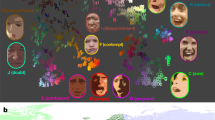Abstract
We analyse the determinants of football fans’ happiness in the Russian Premier League using facial emotion recognition. We propose a new way of measuring subjective well-being and provide its empirical validation using sports data. Our sample consists of about 10,000 photos from football matches uploaded on the most popular social network in Russia during the seasons 2014/15–2017/18. The dataset of photos is analysed with the Emotion Recognition software, which takes a facial expression in an image as an input and returns the confidence across a set of emotions for each face in the image. Next we use multinomial logistic regression to identify the determinants of happiness. The results show that uncertainty and expectations are important drivers of football fans’ happiness. A win decreases the probability of being unhappy, and the effect becomes stronger for late rounds of a national championship. The change in happiness because of a home team win is stronger for males.
Similar content being viewed by others
References
Alexandrova, A. (2005). Subjective well-being and Kahneman’s ‘objective happiness’. Journal of Happiness Studies,6(3), 301–324.
Boychuk, V., Sukharev, K., Voloshin, D., & Karbovskii, V. (2016). An exploratory sentiment and facial expressions analysis of data from photo-sharing on social media: The case of football violence. Procedia Computer Science,80, 398–406. https://doi.org/10.1016/j.procs.2016.05.340.
Buraimo, B., & Simmons, R. (2009). A tale of two audiences: Spectators, television viewers and outcome uncertainty in Spanish football. Journal of Economics and Business,61(4), 326–338. https://doi.org/10.1016/j.jeconbus.2008.10.002.
Card, D., & Dahl, G. B. (2011). Family violence and football: The effect of unexpected emotional cues on violent behavior. The Quarterly Journal of Economics,126(1), 103–143.
Castellanos, P., García, J., & Sánchez, J. M. (2011). The willingness to pay to keep a football club in a city: How important are the methodological issues? Journal of Sports Economics,12(4), 464–486. https://doi.org/10.1177/1527002510385301.
Clark, A. E., Frijters, P., & Shields, M. A. (2008). Relative income, happiness, and utility: An explanation for the Easterlin paradox and other puzzles. Journal of Economic Literature,46(1), 95–144.
Coates, D., & Humphreys, B. R. (2008). Do economists reach a conclusion on sub- sidies for sports franchises, stadiums, and mega-events? Econ Journal Watch,5(3), 22.
Coates, D., Humphreys, B. R., & Zhou, L. (2014). Reference-dependent preferences, loss aversion, and live game attendance. Economic Inquiry,52(3), 959–973. https://doi.org/10.1111/ecin.12061.
Coates, D., Naidenova, I., & Parshakov, P. (2017). Determinants of Russian football club brands. International Journal of Sport Finance,12(4), 321–341.
Cox, A. (2012). Live broadcasting, gate revenue, and football club performance: Some evidence. International Journal of the Economics of Business,19(1), 75–98. https://doi.org/10.1080/13571516.2012.643668.
Croson, R., & Gneezy, U. (2009). Gender differences in preferences. Journal of Economic Literature,47(2), 448–474.
Crossley, A., & Langdridge, D. (2005). Perceived sources of happiness: A network analysis. Journal of Happiness Studies,6(2), 107–135. https://doi.org/10.1007/s10902-005-1755-z.
Diener, E. (2000). Subjective well-being: The science of happiness and a proposal for a national index. American Psychologist,55(1), 34–43.
Diener, E., Oishi, S., & Lucas, R. E. (2003). Personality, culture, and subjective well-being: Emotional and cognitive evaluations of life. Annual Review of Psychology,54(1), 403–425.
Dolan, P., Peasgood, T., & White, M. (2008). Do we really know what makes us happy? A review of the economic literature on the factors associated with subjective well-being. Journal of Economic Psychology,29(1), 94–122. https://doi.org/10.1016/j.joep.2007.09.001.
Durán, J., Reisenzein, R., & Fernández-Dols, J.-M. (2017). Coherence between emotions and facial expressions. In J. M. Fernández Dols & J. A. Russell (Eds.), The Science of facial expression (pp. 107–132). Oxford: Oxford University Press.
Ekman, P. (2007). Emotions revealed: Recognizing faces and feelings to improve communication and emotional life. New York: Macmillan.
Ekman, P., & Friesen, W. V. (1976). Measuring facial movement. Environmental Psychology and Nonverbal Behavior,1(1), 56–75.
Ekman, P., & Friesen, W. V. (1978). Investigator’s guide to facial action coding system: Part II. California: Consulting Psychologists Press.
Elfering, A., & Grebner, S. (2010). A smile is just a smile: But only for men. Sex differences in meaning of faces scales. Journal of Happiness Studies,11(2), 179–191.
Eriksson, K., & Simpson, B. (2010). Emotional reactions to losing explain gender differences in entering a risky lottery. Judgment and Decision Making,5(3), 159–163.
Feddersen, A., & Rott, A. (2011). Determinants of demand for televised live football: Features of the German national football team. Journal of Sports Economics,12(3), 352–369. https://doi.org/10.1177/1527002511404783.
Foroughi, B., Nikbin, D., Hyun, S. S., & Iranmanesh, M. (2016). Impact of core product quality on sport fans’ emotions and behavioral intentions. International Journal of Sports Marketing and Sponsorship,17(2), 110–129. https://doi.org/10.1108/IJSMS-04-2016-010.
Forrest, D., & Simmons, R. (2002). Outcome uncertainty and attendance demand in sport: The case of english soccer. Journal of the Royal Statistical Society. Series D (The Statistician),51(2), 229–241.
Frey, B. S., Luechinger, S., & Stutzer, A. (2009). The life satisfaction approach to valuing public goods: The case of terrorism. Public Choice,138(3/4), 317–345.
Gasparetto, T., & Barajas, Á. (2017). Fan preferences: One country, two markets and different behaviours. European Sport Management Quarterly,18(3), 330–347. https://doi.org/10.1080/16184742.2017.1394346.
Hills, P., & Argyle, M. (1998). Positive moods derived from leisure and their relationship to happiness and personality. Personality and Individual Differences,25(3), 523–535.
Hopfensitz, A., & Mantilla, C. (2018). Emotional expressions by sports teams: An analysis of world cup soccer player portraits. Journal of Economic Psychology. https://doi.org/10.1016/j.joep.2018.04.008.
Jones, M. V., Coffee, P., Sheffield, D., Yangüez, M., & Barker, J. B. (2012). Just a game? Changes in English and Spanish soccer fans’ emotions in the 2010 World Cup. Psychology of Sport and Exercise,13(2), 162–169. https://doi.org/10.1016/j.psychsport.2011.10.008.
Kahneman, D. (2000). Experienced utility and objective happiness: A moment-based approach. In D. Kahneman & A. Tversky (Eds.), Choices, values and frames (pp. 673–692). New York: Cambridge University Press and the Russell Sage Foundation.
Kahneman, D., & Sugden, R. (2005). Experienced utility as a standard of policy evaluation. Environmental & Resource Economics,32(1), 161–181. https://doi.org/10.1007/s10640-005-6032-4.
Kerr, J. H., Wilson, G. V., Nakamura, I., & Sudo, Y. (2005). Emotional dynamics of soccer fans at winning and losing games. Personality and Individual Differences,38(8), 1855–1866. https://doi.org/10.1016/j.paid.2004.10.002.
Lazear, E., & Rosen, S. (1981). Rank-order tournaments as optimum labor contracts. Journal of Political Economy,89(5), 841–864.
McNamee, M. (2003). Schadenfreude in sport: Envy, justice, and self-esteem. Journal of the Philosophy of Sport,30(1), 1–16. https://doi.org/10.1080/00948705.2003.9714556.
Nalbantis, G., Pawlowski, T., & Coates, D. (2017). The fans’ perception of competitive balance and its impact on willingness-to-pay for a single game. Journal of Sports Economics,18(5), 479–505. https://doi.org/10.1177/1527002515588137.
Parshakov, P., & Baidina, K. (2017). Brands or uncertainty? An empirical test of the uncertainty of outcome hypothesis in Russian football.
Pawlowski, T., Nalbantis, G., & Coates, D. (2018). Perceived game uncertainty, suspense and the demand for sport. Economic Inquiry,56(1), 173–192. https://doi.org/10.1111/ecin.12462.
Rees, D. I., & Schnepel, K. T. (2009). College football games and crime. Journal of Sports Economics,10(1), 68–87. https://doi.org/10.1177/1527002508327389.
Rosen, S. (1986). Prizes and incentives in elimination tournaments. The American Economic Review,76, 701–715.
Rottenberg, S. (1956). The baseball players’ labor market. The Journal of Political Economy,64, 242–258.
Ruiz-Belda, M.-A., Fernández-Dols, J.-M., Carrera, P., & Barchard, K. (2003). Spontaneous facial expressions of happy bowlers and soccer fans. Cognition and Emotion,17(2), 315–326. https://doi.org/10.1080/02699930302288.
Smith, R. H., & Van Dijk, W. W. (2018). Schadenfreude and gluckschmerz. Emotion Review, 10(4), 293–304.
Sung, H., Mills, B. M., & Tainsky, S. (2017). From schadenfreude to mitfreude? Estimating viewership loss and rivalrous relationships in otherwise neutral markets. Sport Management Review,20(2), 159–169. https://doi.org/10.1016/j.smr.2016.08.006.
Tainsky, S. (2010). Television broadcast demand for national football league contests. Journal of Sports Economics,11(6), 629–640. https://doi.org/10.1177/1527002509355636.
Tainsky, S., & McEvoy, C. D. (2012). Television broadcast demand in markets without local teams. Journal of Sports Economics,13(3), 250–265. https://doi.org/10.1177/1527002511406129.
Tainsky, S., & Winfree, J. A. (2010). Discrimination and demand: The effect of international players on attendance in Major League Baseball. Social Science Quarterly,91(1), 117–128.
Vallerand, R. J., Ntoumanis, N., Philippe, F. L., Lavigne, G. L., Carbonneau, N., Bonneville, A., et al. (2008). On passion and sports fans: A look at football. Journal of Sports Sciences,26(12), 1279–1293. https://doi.org/10.1080/02640410802123185.
Wang, M., & Wong, M. S. (2014). Happiness and leisure across countries: Evidence from international survey data. Journal of Happiness Studies,15(1), 85–118.
Zhou, D., & Peng, L. (2018). The relationship between the gender gap in subjective well-being and leisure activities in China. Journal of Happiness Studies,19(7), 2139–2166.
Acknowledgements
This paper is an output of a research project implemented as part of the Basic Research Program at the National Research University Higher School of Economics (NRU HSE).
Author information
Authors and Affiliations
Corresponding author
Additional information
Publisher's Note
Springer Nature remains neutral with regard to jurisdictional claims in published maps and institutional affiliations.
Rights and permissions
About this article
Cite this article
Naidenova, I., Parshakov, P. & Paklina, S. Determinants of Football Fans’ Happiness: Evidence from Facial Emotion Recognition. J Happiness Stud 21, 1103–1116 (2020). https://doi.org/10.1007/s10902-019-00119-5
Published:
Issue Date:
DOI: https://doi.org/10.1007/s10902-019-00119-5




